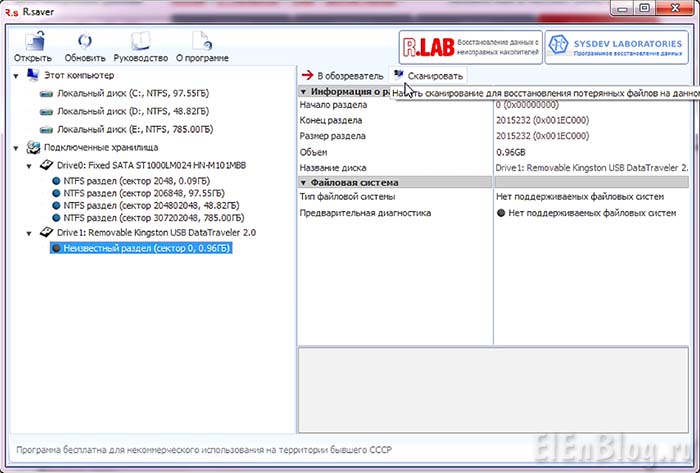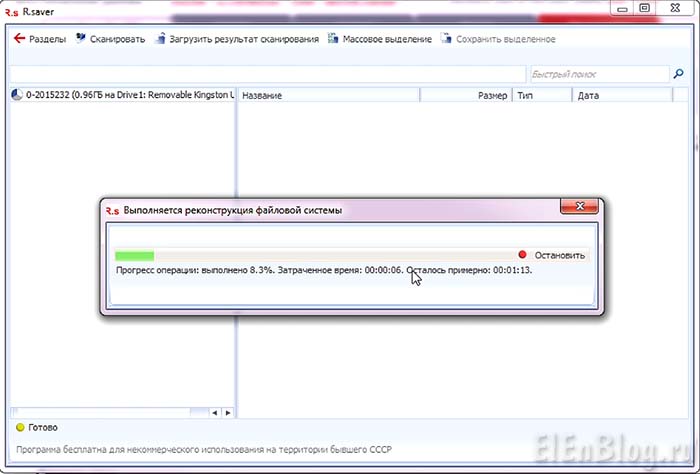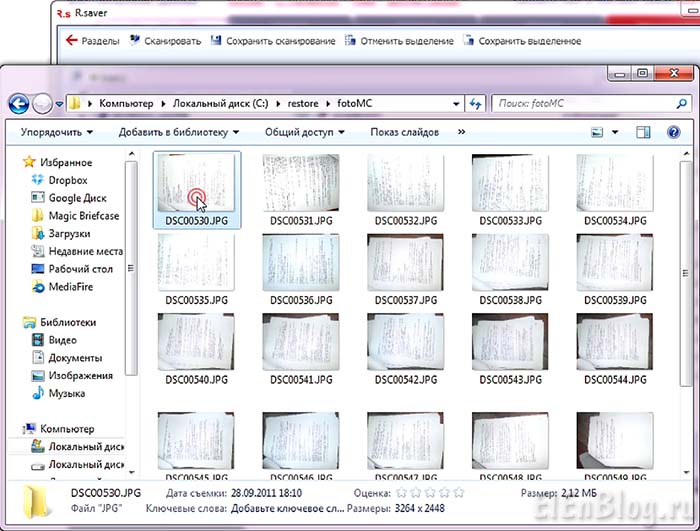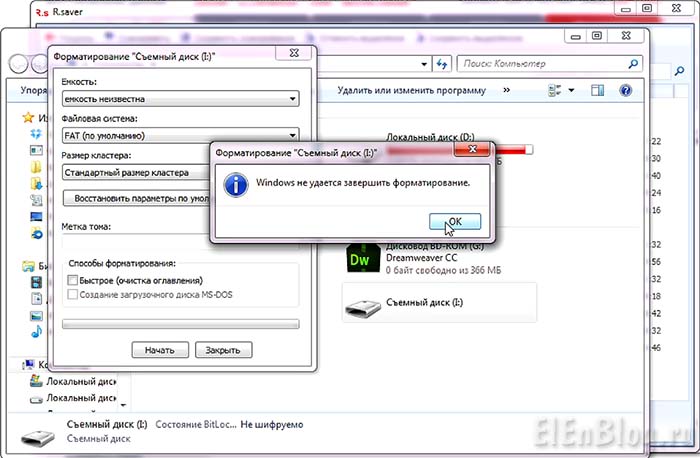Flash in Windows is detected, but when you try to open it, it offers to format the device. In this video I will show how to save data so that you won’t lose it when formatting.
Hello! I have such a flash drive - this is Kingston, an old one at 1 GB, but nevertheless it always suited me, always worked and there were no problems with it.
I rarely use flash drives, but nonetheless.
In general, what is the situation? On Friday I wrote down files from her work, well, and today on Sunday evening I decided to work a bit, to continue working on my project.
Naturally, I inserted this flash drive into the computer to write files to the computer and start working with them, but Windows offers me to format the disk.

No matter how I try, I can not go in and see the files. In general, flash drives are very unreliable devices, so never store files in a single copy only on a flash drive. Those. Whenever possible, always drop these files onto your computer. At work, these files are saved and the only thing I lose in this case is time. Today I wanted to work - but it will not work. Tomorrow I will go to work - and there these files will wait for me - there will be no problems. But it can happen that the files that you have on the flash drive are only on the flash drive and nowhere else they are and they are very important to you.
There is a program that will help you recover all data on a flash drive. At the very least, you should try to use it. I downloaded it, the agreement says that the program is intended for non-commercial use on the territory of the former USSR. Moldova is the territory of the former USSR, so that we can safely use it, especially for non-commercial use.

Well, let's launch it. It does not require any installation. At startup, all the devices that she sees were scanned. And here is our unknown device. Kingston 0.96 Gb - i.e. this is my flash drive.

Let's scan it and see what can be restored from it. In principle, it is quite possible that the memory died in this flash drive.

How the flash drive works: the flash drive has a controller that communicates directly with the usb interface and memory, as well as the memory itself. If the memory dies, then the flash drive is still visible, everything is fine with it, but then nothing works, nothing is read. Let's hope that in my case, some kind of error occurred and everything will work. But maybe, as I said, a faulty memory and then we won’t restore anything. The scan is over, now reconstruction is in progress file system. As you can see, everything about everything takes 2-3 minutes.

Hurrah! It is all over. Yes, indeed: the backup folder, the photo folder. See how everything is fine - everything was restored.

Now we need to select the files that we want to save. You can click the mass selection button and check the box, make sure that we are now in the root and save everything, all files. Click "save selection", select where we want to save.

I will immediately make a new folder on drive C. We will save here. Naturally, this takes a little time. But we will wait.

Most importantly, we were able to recover all our data. In my case, this is not entirely important, because I can go to work and download everything. But sometimes it happens that really on a flash drive the information is stored in a single copy and this opportunity save data is worth a lot. Moreover, the program is generally free. Elegantly simple. And thanks to the guys for making such a simple, convenient and useful program.
Well. Let's see the result. Here is our C drive, daddies restored. And directly pictures, there is everything. Not bad! Even good.

We were able to recover all the data. The memory of the flash drive is working. And it remains to deal with it so that it is normally detected in the conductor and it is possible to work with it. It seems that you just need to format it. Formatting it will not work. In another video, I will describe in more detail how to bring it to life. Since conventional formatting does not produce results. We try and get the error “Windows cannot complete formatting”.

Here you already need to look for other solutions.
Well, all for now and good luck to everyone.
As it turned out later, formatting fails, and everything reads again. How to cope with this situation, I showed in the video.
All computer users already use flash drives in one way or another. I already wrote about. A generation of people has already grown up who saw floppy disks only in pictures. But despite the fact that the flash drive is a very convenient thing and it seems eternal - sometimes it is still damaged.
So what to do if the flash drive is broken:
In general, the small size of the flash drive contributes primarily to its ... loss. Yes, yes, most flash drives lose, not break. But breaking a flash drive is not such a big problem. Over time, competition among manufacturers led them to switch to cheaper materials and structures, which naturally damage faster. And it is not surprising that some of my friends boast that their flash drive is already 5 years old, while others are annoyed that they bought a new flash drive and it broke only because it was dropped from a height of 2 meters.
There can be three main problems:
1) mechanical damage
2) electrical and thermal damage
3) controller failures
Maybe there are some others, but these are the most important and difficult to eliminate.
1. The first problem is becoming less or less clear - we constantly drop flash drives, throw them at each other, carry them in our pockets, sit on them, etc. Basically, of course, the case suffers, which can simply crack or begin to leak moisture. But it also happens that cracks occur on the board itself, which is very sad. If the memory chip is cracked, then consider that you have lost data. If your flash drive gets into the water, then dry it thoroughly before using it: a day, or rather two, keep it in a dry, warm place. All contacts must dry out, otherwise there is a great risk of losing important data, and even the flash drive itself. Therefore, when choosing a flash drive, try to stop the choice on flash drives with a durable case.
2. Many inexpensive flash drives have poor protection against voltage surges. Therefore, sometimes in homes with poor wiring, there is a risk of electric damage to the flash drive. The connection moment is especially dangerous - therefore, before inserting a USB flash drive into a computer, it is recommended to touch the case with your hand to level potentials. Best protection against electrical and thermal damage in flash drives in an iron case. Repairing flash drives that burned out due to power surges is often more expensive than the cost of a new one.
3. The controller is available in all flash drives, it is responsible for transferring data between the external interface and flash memory, and performs many other equally useful functions.
Controller firmware is subject to a lot of various influences, including power failures, interface errors, etc. In such cases, the controller locks up and stops responding to requests from the operating system. Outwardly, this is manifested in the fact that the drive is recognized in the computer as " Unknown device", Or how removable drive with zero capacity. When a user accesses it, the messages “Insert disk into drive” or “No access to disk” may appear.
Controller firmware recovery is carried out using special technological utilities. Often, these utilities come with a USB flash drive. In extreme cases, such utilities can always be downloaded from manufacturers' websites. The utilities are strictly specialized, and you need to have a version specifically for your controller model. It is not enough to know only the drive model, because in different instances of the same flash drive there may be controllers from different manufacturers.

So, if you think or know what you have broke down, then you should not panic, it is worth determining the cause of the breakdown, and is it worth it to repair the flash drive (this is already determined by the value of the information on it) or is it easier to buy a new one. It is worth remembering that a repair with a 50 percent probability will cost you more and not the fact that the flash drive will last long after external intervention.
Asking questions
Comments on the site
In my case, a breakdown occurred inside (at the outlet) of the plastic adapter. Carefully cut the plastic from the circuit board with a sharp knife. There are four pins on the board that lead to a USB port. They need to be soldered to the corresponding contacts of the working connector.
I think that it’s unlikely to use the old connector to restore the flash drive - at least it is difficult to do. It is easier to cut off the connector with a piece of cable from the extension cord, which is often equipped with flash drives.
Do not know how to solder? Arm yourself with conductive glue.
Bottom line: 20 minutes - and in your hands a restored flash drive. You can even continue to use it by wrapping electrical tape. But this, IMHO, is already for perverts ...
Wire Colors for Cables and Pinout USB, micro-USB, USB-B
| Contact number | Designation | Wire color |
| 1 | V BUS | red |
| 2 | D− | white |
| 3 | D + | green |
| 4 | GND | the black |
My blog is found in the following phrases
In this article I want to tell how to restore a USB flash drive: about all available methods of "revitalizing" damaged, inoperative, malfunctioning, faulty usb drives. On the Internet, you could find many manuals for the restoration and repair of so-called flash drives, but I offer the most full instructions, which includes all the available methods, as well as tools.
It's no secret that the popularity of flash-drive is simply huge. Now it is not just a storage device, but also an accessory that is always with you. If 10 years ago only a wealthy person could afford a flash drive, today it has become the same consumer goods as, say, a lighter.
However, let's not forget that the main purpose of the flash drive is convenient data storage on a compact device that can be used for various purposes - copying information, transferring user data, storing backup copies of important data and everyday copying.
Advantages and disadvantages of a flash drive
It is important to note why this device has become so popular. The main advantages of flash-memory:
- Compact and small size, dimensions
- No noise during operation
- Great dubbing potential, high resilience
- Reliability, data storage periods on a USB flash drive
- Versatility and accessibility, work with usb port
- Endurance, high degree of protection against external damage
- Large amount of information storage
- Low price
Unfortunately, not everything is so rosy with all the advantages of a usb flash drive as a storage device. Very often the drive breaks down, becomes unusable. The user, as a rule, does not think about restoring the USB flash drive - in the case, of course, if he has not lost any valuable files along with the breakdown of the flash drive. Basically, people do not "bother" when buying a new storage medium, all the more so since low cost does not repair flash drives, but simply finds a more capacious and reliable replacement.
Causes of flash drive failure
Let's look at the reasons why a flash drive can easily fail, regardless of its model and workmanship, price.
- The flash drive was incorrectly removed from the usb slot.
- Exhausted potential (memory worked out)
- Power and voltage surges
Generally speaking, there are many other reasons that entail recovery. As a result, as a rule, the flash drive controller is the first to fail. What are the main symptoms that occur in these situations? You insert a USB flash drive into the usb connector, and instead of displaying a separate drive to which you can copy files, the system says that the drive needs to be formatted, the device is not available, or you see that the media is on.
Note: raw, in this case, is not a file system markup format at all, but evidence that the OS cannot determine its structure. This happens due to the fact that when the flash drive breaks, the file table is violated, service information can be destroyed, among which the file system format is indicated.
It often happens that a flash drive is not writable while in read-only mode. What is the reason for this malfunction? A flash drive, knowing that she has not much time to live, goes into self-defense mode of memory and instructs the controller to not allow recording to save the physical structure of the device. However, sometimes blocking happens for a more banal reason: the controller on the flash drive is out of order, so it is not possible to write data to it. However, there is, if it is write-protected.
This, of course, is not very good news for those who are going to repair the flash drive: for such repairs, special equipment and skills will be required. In a more optimistic scenario, you can restore using flash drive recovery programs.
What to do if a flash drive breaks
- a) restore data on it;
- b) repair the flash drive.
Warranty Exchange
When you bought a flash drive, you probably were given a warranty card, which indicates the conditions, terms of distribution of warranty service. So? So. If the flash drive crashes just at this time interval, you can safely contact the seller with a request for a replacement. Please note, however, that no one will recover data on a USB flash drive. You will simply be given a new flash drive, since it is completely impractical to make repairs and even more so restore deleted files.
Repair physical damage to a flash drive
If you assume that the hardware is not damaged, you approximately know the causes of the breakdown and you do not mind sacrificing all the files, you can take the risk and format the flash drive. Make an informed decision: do you really need to recover files from a flash drive? Are you ready, say, to sacrifice them for a higher purpose - the "treatment" of the drive itself? If you still decide that the files have very valuable weight, you will have to contact the company to solve your problems for a fee.
These companies use special equipment and tools sharpened for the restoration of printed circuit boards. Steeper companies remove the NAND memory chip from the board to extract raw data.
Prices for recovering deleted files from a USB flash drive can vary between $ 20 - $ 850, depending on the degree of damage to the device and the type of "healing" applied.
Flash Recovery Tools
If you consider that you can risk files, then you will need the following tools:
- Soldering iron with flux
- Old usb cable
- Nippers / Pliers
- Small flat screwdriver
- Magnifier or magnifying glass.
All this will help us to effectively restore the flash drive. However, it should be noted here that further steps will make sense if the cause of the breakdown is a broken connector on the flash drive.
So, picking up a screwdriver, release the drive from the protective case by unscrewing the top cover.
Now take a magnifying glass, look through it at the printed circuit board. If the pads are damaged, then you will need the help of professionals.
Please note: pads contain 4 solder bits connecting the connector pins to the copper tracks in printed circuit board. If the connector breaks off without causing damage to the circuit board or pads, go to the next step when working with a USB flash drive.
Place the restored flash drive on a hard surface so that the end of the connector faces you with the contact pads up.
Use wire cutters to cut one end of the usb cable. Bite off the female end if it's not dad-to-dad.
Using a stripper, strip about 0.6 cm of each of the four wires inside the cable. If you do not have a spare USB cable for use, you can solder the pieces with an electric wire to each of the teeth for a broken connector; Thus, you create your own mini USB cable.
Solder each of the four wires to the four pads. Colors from left to right: black, green, white, red. They should join the sites in that order.
If you used your wires instead of a cable, simply solder each wire to the corresponding pads regardless of the color of the wire.
Plug the other end of the usb cable into the computer and cross your fingers. If he defines the flash drive as a device - great! Just save the files to your computer.
If the keychain is still not recognized, then most likely there is another problem that cannot be seen with the naked eye. Either think about going to a company where they know how to restore a USB flash drive, that is, or hang it on a wall - there will be a cool decoration on New Year instead of a garland.
Error Scan (Windows)
USB port testing
Sometimes the reason is not in the flash drive, but in the connector with which it is docked.
Remove the flash drive, restart the computer, reconnect.
Test usb on another computer. If the flash drive works there, the reason is clear.
Sometimes it happens that one port on the computer works, and the other does not. Therefore, I advise you to check each of the ports, then try to use the ports on other computers.
USB drives are inexpensive and widely available. Think about a replacement when installing operating systems - it will cost you much less time and headache.
If you decide to turn to professional recovery services to recover a flash drive, do not forget to talk about the problem to the best of your abilities to make sure that they have normal tools and experience in this field.
If all else fails and you don’t really care, contact your flash drive manufacturer for assistance. e-mail or through the forum. They may have a utility for rebooting the firmware to perform low-level formatting of the damaged disk.
If your USB flash drive really does not contain important data, and you would like to get it, do not format it! While there may be no visible damage, one or more internal components may have gone bad. You can try to check for blown fuses. To do this, remove the outer casing / shell of the device and under the magnifying glass find one of the tiny transparent cuboid components on the circuit board. If one of these fuses is black instead of clear / transparent, then it has burned out and requires professional restoration.
How to use a flash drive
So that the flash drive does not break, I want to give you some simple tips on how to “take care of” it.
- Remove memory from usb slot correctly, in safe mode. This option is available in almost any operating systemon any computer. This is necessary so that during the extraction the file copy and read operations on the USB flash drive are not interrupted. If you remove the memory incorrectly, there is a possibility of data loss and even damage to the drive.
- Do not drop the flash drive, do not kick it, do not throw bricks at it. She is afraid of damage, physical and mechanical influences, sensitively reacts to temperature changes, weather conditions. Do not drown the flash drive, do not drop it in the toilet, do not put it in your mouth. There is a chance then not to restore the flash drive. Do you need it? .. Generally speaking, when you buy a product, make sure that it is perfectly protected by an integral case. It should be aluminum at least, not plastic.
- Always - that is, a backup of all data. This is the coolest protection against deleting information. If you suddenly lose valuable data, you can change the flash drive under warranty (or buy a new one) with a quiet arc, and then transfer files with backup on a flash drive. Backup is a very simple procedure, it runs quickly, it can be configured on a schedule.
That's all. I hope some tips from this guide on how to recover a flash drive will help you get the data back. Thanks for attention.




